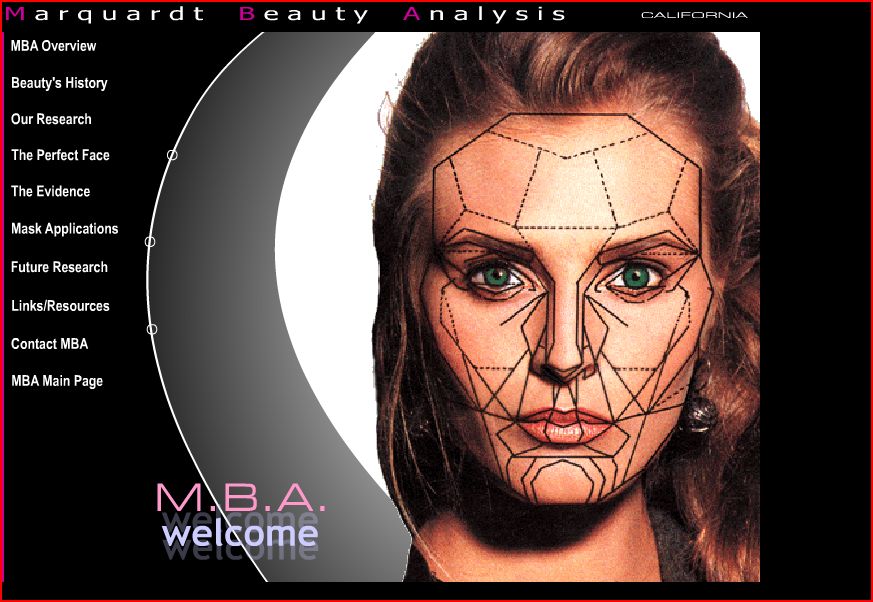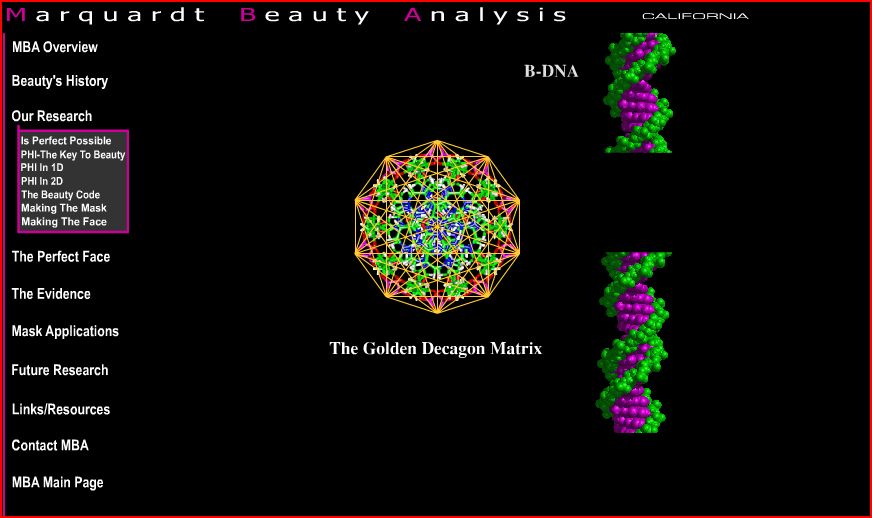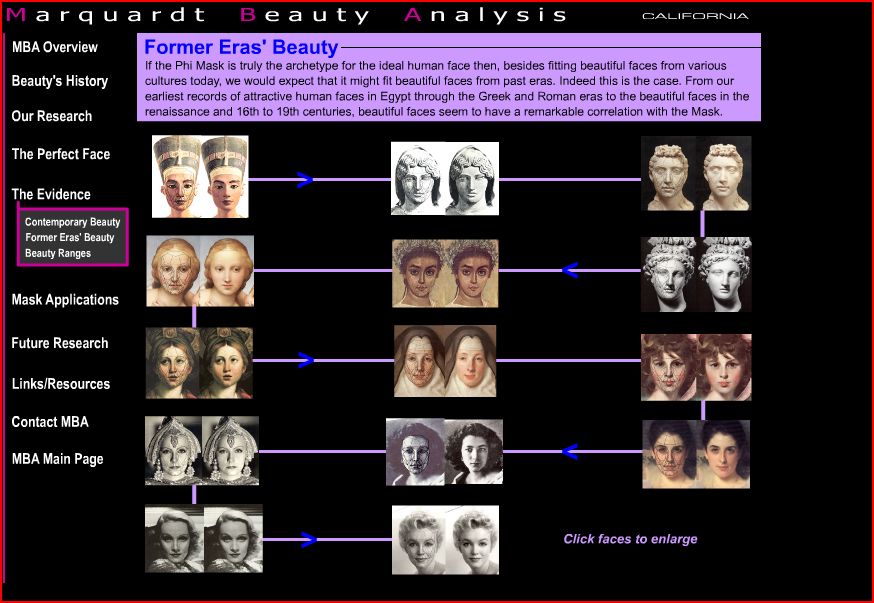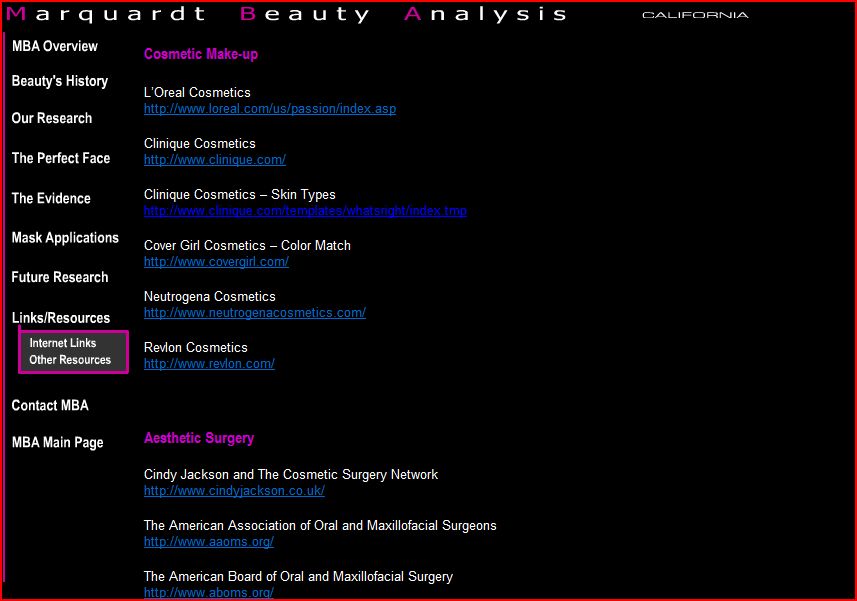Michael Kimmel argues that, for contemporary Americans, science is a superstition. Scientific explanations are comforting and often accepted without critical thought. The word “natural” rolls off our tongue and frequently gets conflated with “good.” We are obsessed with finding the biological origins of sexual orientation, gender difference, political proclivities, happiness… everything. Once a biological basis is found, it is considered the whole explanation. It is as if biology is more fundamental and more true than things like culture or society.
Our “faith” in science, then, is useful to marketers insofar as they can claim that their product is objectively tested, engineered, or otherwise scientifically sound. This brings me to this Marquardt Beauty Analysis website, sent in by Kiran D. The website explains the science behind beauty. The main page includes a woman’s face overlaid with complex geometric shapes:

Here is part of the mission statement (emphasis mine):
MBA is dedicated to proactively researching human visual aesthetics, including its biological and mathematical bases, and to utilizing the results of that research to develop and provide information and technology with which to analyze and positively modify (i.e. improve) human visual attractiveness.
MBA further is dedicated to tailoring and formatting this technology to specific uses for direct applications in the fields where human attractivenss is a factor or parameter (i.e. those fields interested in human visual attractiveness) including medicine, dentistry, psychology, anthropology, biology, anthropometry, the arts, cosmetic makeup, and fashion, as well as for direct use by the individual consumer.
Notice how they use scientific buzzwords like “bases,” “formatting,” “applications,” and “parameter.”
Here is a screenshot showing how they have tried to “scientize” beauty and make their endeavor look like legitimate science:

On the page below they claim that their formula works across history (elsewhere they also claim it works across race), so they argue that their science is objective and not culturally or historically contingent:
The website, of course, is not really about research on beauty; it’s a mechanism with which to sell make-up, cosmetic surgery, and other products. Here is a screenshot of the first part of the links page:
The page includes links to L’Oreal, Clinique, Cover Girl, Neutrogena, and Revlon; five “aesthetic surgery” links; three “aesthetic dentistry” links; and a handful of academic-y sounding links.
Thanks Kiran!



Comments 8
Benjamin Lobato — December 16, 2008
Of course they use the golden ratio to explain their "research" on beauty. This is probably the most frequently abused mathematical concept used to legitimate pseudoscience. And I like that the first site linked to in their Mathematics/Geometry resources section seems rather skeptical that the golden ratio has anything to do with Aesthetics.
JenniferRuth — December 16, 2008
Using the golden ration to create a mask of "ideal" beauty was developed by Dr. Stephen R. Marquardt who is a member of the Society of Maxillofacial Surgeons and Chief of Research in Esthetic Facial Imaging at UCLA.
However, Dr. Marquardt has never published the validity of his mask in a peer-reviewed journal.
There is an article in the Aesthetic Plastic Surgery journal (published in Jan 2008) that criticises the mask based on the fact that the standard of beauty Dr. Marquardt chose was that of white, under-weight fashion models.
http://www.springerlink.com/content/6664h54372486p35/
I can understand the benefits in developing such a mask when you think about reconstructing faces following terrible accidents. But the mask that is currently proposed is flawed.
Penny — December 16, 2008
Funny that at least one of the "former eras' beauties" is a child--"Pinkie" is one of the best-known paintings at the Huntington. The subject, Sarah Barrett Moulton, was about 11 years old when the portrait was made, and she died the next year from tuberculosis--hardly the "beauty ideal" I'd want to hold up for healthy adult women.
http://en.wikipedia.org/wiki/Pinkie_(painting)
Benjamin Lobato — December 16, 2008
I found a formal criticism of Dr. Marquardt's theory here:
http://www.femininebeauty.info/stephen-marquardt-phi-mask-refuted
Looks like he is not taken very seriously by the scientific community.
Elena — December 16, 2008
Unsurprisingly, all the examples come from the Western world. The ideal of female beauty in China and Japan, for example, was quite different with a round face and small features (and sometimes, like in Heian-era Japan, eyebrows redrawn in the middle of the forehead and blackened teeth).
Try applying that canon to these beauties from Kunisada II or this Qing dinasty lady. For a tridimensional version of this, Noh masks of the ko-omote type depict the Heian-era classical Japanese ideal of beauty that I mentioned earlier.
Sociological Images » BEAUTY SCIENCE — February 20, 2009
[...] another example of this phenomenon, see here; for another example of vibrating beauty care products that may or may not be intended for [...]
Sociological Images » The Beauty Industry: Spending And Routines — May 15, 2009
[...] more on beauty and spending, see our posts on the scientizing of beauty products (here, here, and here), our post on how Dove and Axe are in bed together, and this post on the economics [...]
Liyana T — May 16, 2009
wtf?! AHHHH!! That is freaky shit right there. Marquardt beauty analysis, its sickening that we actually pass thru these things and never realize a single thing.